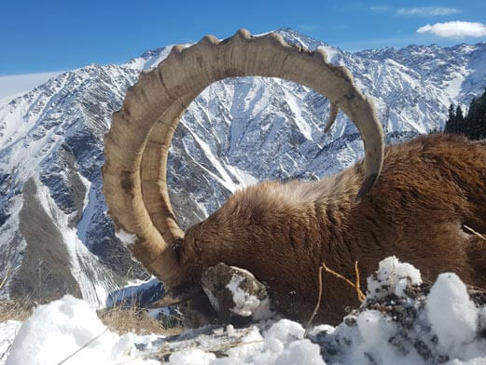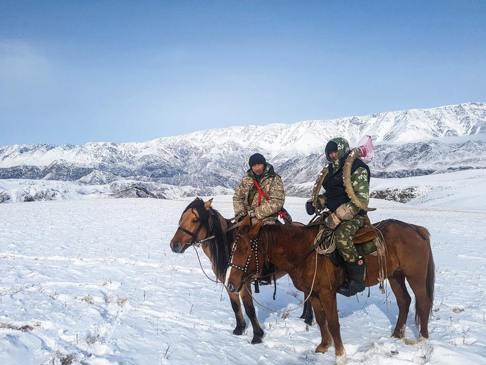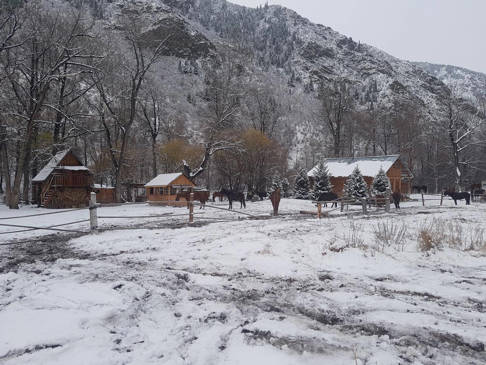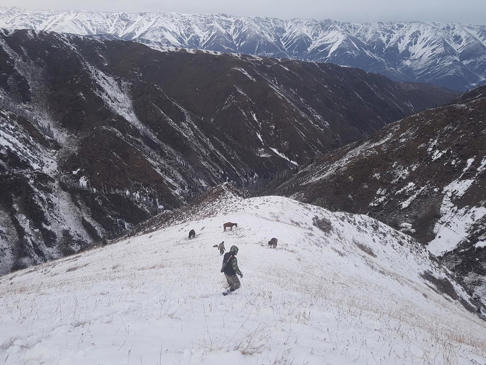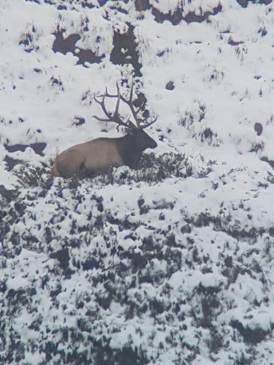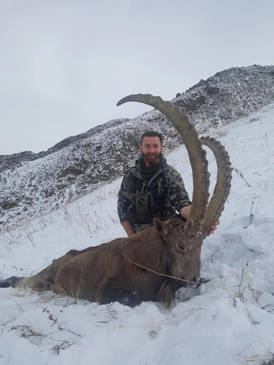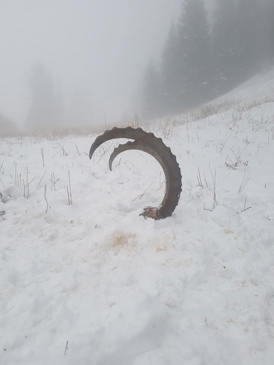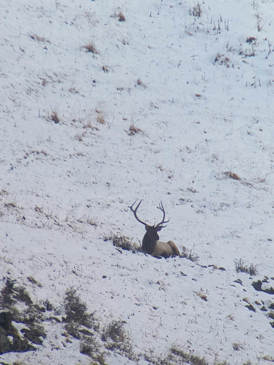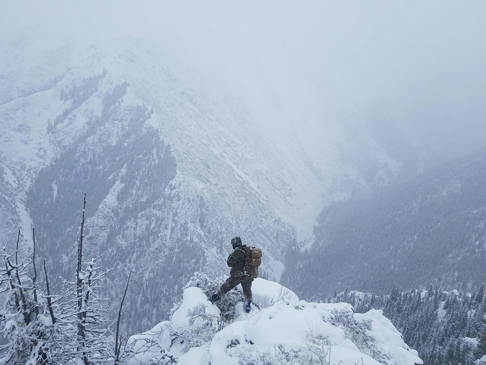We slowly uncurled our bodies from the Hilux and stepped out into the cool night air. We’d arrived at camp at last. It was around 7pm as we met our guides and camp staff – everyone was friendly and happy to see us – we were just glad to be out of the truck!
Our team was made up of me, Rob and my Uncle Bernard and by the looks on the faces of the airport staff in Almaty, it was evident they don’t get many Kiwi tourists in Kazakh.
We had left Almaty that morning at around 3.30am and 300 kilometres of highway driving were followed by 200km of one of the worst roads you can imagine. Then we topped it off with a leisurely 200km of bone-crunching off-road travel. Our driver Yerdos put in a superhuman effort that day. With 22 hours of flying and a 14-hour layover in Dubai on the way, we were well and truly over travelling and glad to sit down to a proper meal.
It seemed like we’d been planning this trip to hunt Mid-Asian ibex for my whole life. Uncle Bernard had wanted to do it for his 50th birthday and I was going to be the bag boy…ten years later we were finally here.
Kyrgyzstan, Tajikistan and Kazakhstan are the three main countries people talk about when hunting ibex. I had sent out enquiries to guides and outfitters across these countries and we settled on ‘Pro Hunt Kazakhstan’ for our Mid-Asian adventure. One of the owners of this company, Kazhym joined me in mid-2018 for a tahr and chamois hunt. This gave me a lot of confidence for our trip as Kazhym was an honest and genuine guy and I was sure we would have a great hunt.
Kazakhstan is by far the largest of the ‘stans’ and the largest land-locked country in the world. Compared to other ‘stans’ Kazakh is relatively rich and modern. Huge reserves of oil, gas and minerals have boosted the economy since the Soviet collapse, resulting in Kazakh being the biggest economy in central Asia.
Hunting-wise, Kazakh has good populations of both Mid-Asian ibex and Tian Shan elk (commonly called maral) as well as Siberian Roe deer, wild boar, wolf and upland birds (chukar) and many waterfowl species. There are also Eurasian brown bears and a few species of sheep (Argali and Urial species).
The Mid-Asian ibex live throughout the Tian Shan mountain range. Some 3000km long, it stretches from where the range meets the Pamirs in the south (Tajik) through Kyrgyzstan and along the Kazakh and Chinese border to where it joins the Altai mountains in the north-east (Mongolia). There are many other species and sub-species of ibex, but Mid-Asian are the largest and also the most commonly hunted of the species.
Hunting for ibex is normally started in late summer (August) and runs through the winter in some areas. We had planned on late October, which would hopefully see the very start of the rut, while avoiding major snowfalls.
As we sat down for our first dinner in base camp, we were all a little excited and nervous. Tatyana (our cook) brought out what can only be described as a restaurant quality two-course meal for us, and we soon learned this was to be the norm.
We chatted with Dennis, our translator and Anatoli, the area manager over dinner and soon had a plan figured out. Our hunting area was about 32,000 hectares (80,000 acres) within a greater 187,000 hectare (462,000 acre) wildlife area. Anatoli explained there were around 3000 ibex in our area, with an annual harvest of only around 10-15 billies. Such a low harvest rate ensured there would be plenty of mature billies around.
We were to leave the base after lunch the next day and camp out for 3-4 days, with each hunter heading into his own area with one guide and one assistant. Our base camp was a collection of houses, nestled among some large poplars in a tight valley bottom.
I was up early the next morning; it was cool outside and good to try and get my bearings. I always get pretty disoriented when I travel to the northern hemisphere; it seems so alien having the sun to the south. Once you realize south is north and north is south, then it all makes sense.
I chatted with one of the guides in broken English as he brought the horses in to be fed and saddled up. Back inside, Tatyana had a cooked breakfast prepared and endless cups of tea for us. Our base house was very nice with central heating, running water and a hot shower – a great surprise!
By lunch we were packed and ready to go. The guides left with the horses and we soon caught them up in the wee Russian jeep. Bernard and Rob headed off with their guides and I continued on in the truck to a different valley where my guides, Sergan and Ali were waiting.
As the guides packed the horses, I glassed into our valley. A small group of maral sat in the open snow and not far off a mob of around 25 ibex grazed among the rocks. Our Kazakh horses were not the small ponies I had imagined, but fair-sized mountain horses. Well-fed and with good saddles, they carried us easily down the steep track to the valley floor.
After a couple of hours of riding, we set up our camp. We had a quick meal of rye bread and sardines and soon headed off to check out the ibex and maral. The horses were left pegged out on the ridge as we made the last couple of hundred yards on foot.
We knew exactly where the ibex were and our short stalk put us within 500 yards of the mob.
The group was mixed females and young with five or six billies among them. I wrote out ‘110cm’ and ‘115cm’ (43-45”) on my hand and Sergan nodded his head.
I was confident we would have more opportunities so we sat and enjoyed the views. By the time it was dark we had seen three nice maral bulls with their respective cows, and around 20 Argali were spotted in the distance.
Day two of the hunt never really dawned. I unzipped my tent to a complete whiteout. Most of the day was spent in the tent, eating and learning a few Kazakh words. Sergan and I slow-stalked some bluff systems in the evening but it was a frustrating exercise in the low cloud.
We were up early on day three. It had snowed 6-8 inches overnight and there were still a few flakes falling as we headed up the valley. We rode steadily from camp to a high pass and once we reached the top, the terrain opened up to a large plateau. The wind was rather brisk and snow fell steadily.
We soon dismounted and started to glass. Not 500 yards off, Sergan and I spotted a lone billy that we figured was around 110cm (43”). After a few minutes he got sick of us and trotted into some nasty cliffs. As I was just thinking ‘he’s probably not alone’, six more billies came into sight and followed him. Two of them caught our attention and as soon as they were out of sight, we made chase. We followed their tracks into the bluff system, to no avail. Disgruntled, we made our way back to Ali and the horses. Off again across the plateau we rode for an hour to our next glassing point.
The conditions were best described as ‘blizzard’ as we sat on a windy knob trying to glass. The wind and light powder snow made it a rather fruitless task. Sergan and Ali were pretty concerned with getting lost in a whiteout (which was fair enough) so we headed back to the ponies. We had a slight moment of panic as the horses had pulled their stakes and headed for some shelter, but luckily we found them less than a hundred yards off. It was amazing how quickly their tracks were covered up by the wind and light snow.
While the boys sorted the horses, I took the opportunity to look into a far-off valley where I spotted a lone billy. Despite the wind and snow, I could see he was a standout, the best we had seen by far. I quickly showed Sergan. After a bit of discussion, the guides explained they could not ride there, and they didn’t want to die in a whiteout. I was pretty keen to head after the billy, but I accepted the call and we rode back to camp. It was a slow and cold ride and I was glad to have good gear.
Luckily our camp was very sheltered. After a warm meal, we dropped camp. I was hoping we were heading to the good billy we had seen, but Sergan wanted to explore another valley. Given the language barrier, it was a little confusing to figure out their plans but I tried my best to trust their judgement. As a guide myself, I know we often might seem to be doing something the wrong way round, but most guides do their very best to ensure their hunters have the best success possible.
We retraced our tracks from the previous days. The weather had pushed the ibex low into the valley and we passed a few small mobs in the creek bed. As we made our way up a tight gorge, I spotted some movement in the rocks not 500 yards away – it was a BIG billy!
I jumped off my horse in a panic and started walking up the track. The ibex were out of sight now, behind a small crag. Ali and Sergan had not seen them and wanted me to get back on my horse. I tried to explain what I had seen but I don’t think they got the gist of it.
With the horses hot on my heels, I plodded up the track with my rifle at the ready. I veered off the track to get a wider angle on the face as Sergan and Ali continued on. Sergan and I both spotted the billies at the same time – just 200 yards up the face – six of them were staring straight at us. I was sitting in the snow ready to shoot but the guides and horses were between me and the game. Sergan quickly pulled the horses back and the ibex took off. I fired two shots in anger at the lead billy as he ran across the face. He had big curling horns and was a very impressive animal. My shots ran wide and the ibex were soon over the skyline.
A few stern words were spoken, but it was what it was, communication can be difficult in such a situation. After a few minutes I started to relax and we carried on.
An hour later, we set up camp on a high plateau. We had bumped four mature Argali rams on the way, which were cool to see.
Late that afternoon we were looking into a new valley. We had left the horses and approached on foot. The wind was blowing hard again but we spotted plenty of ibex. Across the valley were two groups, about 25 in each, and further up the valley was a smaller group with one large straight-horned billy. We watched them until we were too cold to glass, then headed back to camp.
Day four dawned white. With a good breakfast under our belts Sergan I headed off into the cloud. As we neared our valley we came out of the low cloud into a beautiful sunrise. We pegged the horses out and headed down to our glassing spot from the night before.
Within a few minutes we were looking at a good mob of ibex not 500 yards beneath us. The straight-horned billy had moved down the valley overnight and he was right below us. It was a perfect situation. The ibex were happily feeding as the slight breeze was in our favour. All that was required was a slow slither down the face into range.
My range finder was rather slow to get going, I think the cold and partial mist was to blame, but we got to a point that Sergan and I both thought was around 300 yards. I got into a bit of an awkward position and a final range confirmed the shot was about 350 yards. The old straight-horned billy was busy feeding on a tussock as I gently squeezed off. The shot felt good, but the reaction wasn’t great.
The ibex milled about confused, and the big billy stood shaking his head. Then he trotted off a few yards and stopped again. This time I aimed low on his brisket, anticipating he would walk forward. The shot broke clean and the billy dropped with a broken neck so Sergan and I were both happy. A quick replay on my phone showed my first shot had been high and had caught him through one horn. Sergan was quickly on the radio to Ali to share our success.
We sat with our billy and enjoyed the warm sun as it entered the valley. Ali joined us with the horses and after a quick photo session, we began to process the animal and soon had all the edible parts in the saddle bags. We were back in camp before lunch; the horse hunting sure made things easy!
As we were sitting in the sun, the radio crackled to life. It was Anatoli; my uncle was back in base camp and they were heading this way in the truck to see how we were getting on.
The wee Russian jeep crawled up through the snow, almost making it to our camp. After a quick meal we headed back to base camp with the gear in the truck and the horses not far behind. Bernard and Rob had both had good success over the last few days, taking mature billies. We spent the rest of the day sharing stories and enjoying some more great food.
Day five dawned on a crisp clear morning. I checked my rifle after breakfast and was glad I did. Despite sighting it in a few days earlier, it was shooting around 3 inches high at 100 yards and with dialling up, this was only exaggerated at longer distances. A couple more shots and I was feeling a lot more confident.
Sergan, Ali and I headed off up the valley from base camp around mid-morning. I was happy with my ibex but wanted the opportunity to do some more hunting and explore some new country. We rode up the valley for about two hours through mature poplar trees and then into smaller pines and spruce as we gained elevation. The maral sign through the valley was impressive, huge areas were churned up and there were rub trees everywhere. Several of the rubs were higher than my head – and I was sitting on a horse!
The valley soon narrowed and began to gorge out where a small log herder’s hut marked the end of the trail. As Ali began to set up camp, Sergan and I worked the surrounding country with the glasses.
A small boar was feeding high on a ridge, two billies sat in the crags above a digging brown bear and a mob of nannies and young fed in the gorgy cliffs…there were animals everywhere.
Then across the valley Sergan spotted a group of 20-odd ibex with two billies that soon caught our attention. With the spotting scope fixed on them we agreed that one of the billies was worth a closer look. He was dark chocolate brown and his horns had a very impressive deep curl.
We set off quickly, crossing the creek which involved a few gymnastics over frozen rocks and two fallen trees covered in snow. Luckily we were both light on our feet and were soon crawling up the frozen river bank. For the first time we were dripping sweat and had to take a wee break to lose some winter layers. The sun was shining strongly and it was a beautiful day to be in the mountains.
We soon made the edge of the spruce trees and took a sneak peek into the chute holding the ibex. They were starting to bed down on the grassy face, as we had thought. We plugged our way through the knee-deep snow just inside the edge of the trees. Eventually we got to a flattish spot and I prepared to shoot. The big billy was sitting in the long grass but his curling horns were easy to distinguish from the others.
Sergan sat in the edge of the trees, while I slithered out into the snow. I knew they would see me as soon as I left the trees and sure enough, the ibex were soon up and milling about.
The big billy was the last to stand. The shot felt perfect and I watched as he took a few steps forward and then reared over backwards. Sergan and I were both ecstatic; it had been a perfect stalk and a perfect shot – and it wasn't even lunch time!
After a short steep climb, we were sitting with the big billy. We ate a couple of Tatyana’s pastries and then we caped him out. With a slight push, he started off down the chute and didn’t stop until the snow ran out. We half-skied down after him, I added his back legs to my pack and we carried on. By the time we reached the herder’s hut, Ali had the horses packed up and a warm meal cooked for us, what a guy! We trotted back into camp by 5pm after an awesome day of hunting.
The next two days were very much a case of ‘hurry up and wait’. Our driver was having some mechanical issues on his way in to camp so we ate and rested and boiled our ibex heads.
Eventually our driver arrived and six of us crammed into the new truck with all our gear and bid farewell to our camp. Our guides left on their 200+km horse trek home. After three months away, they were understandably eager to see their families.
Our drive out was rather uneventful. We changed into our familiar Hilux halfway out and then started again on a very long and slow drive back to Almaty. The poor Hilux was running on only three cylinders and it was the early hours of the next day before we made it to Almaty.
We explored the city for a few days before our long flights home. Almaty is a modern and rich city, not at all like you would imagine. It was very clean and seemed very safe. The Kazakhs are friendly and welcoming people and their country has a lot to offer as a tourist destination.
